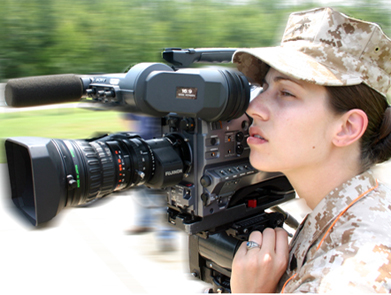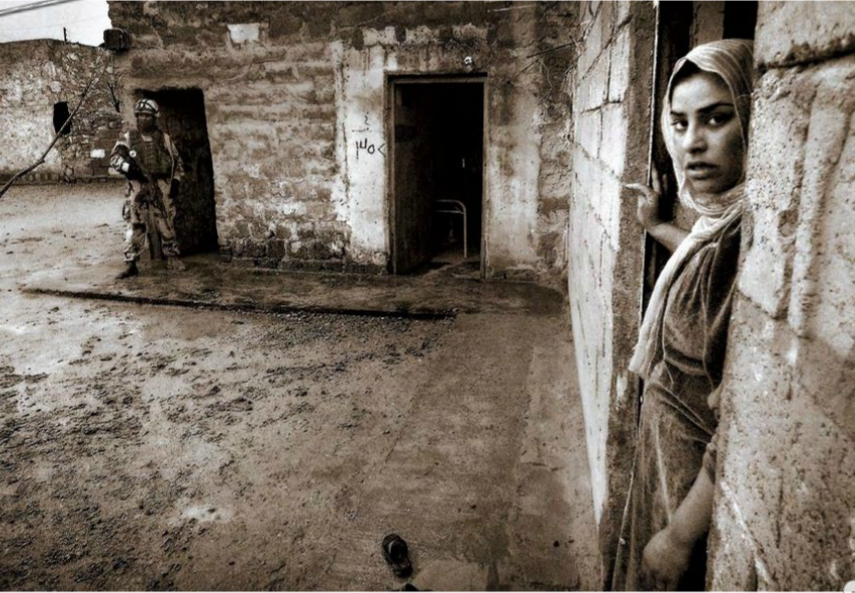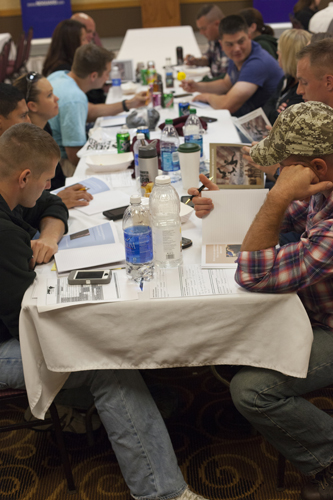The Washington Post reports that in reaction to the Supreme Court decision involving the Defense of Marriage Act earlier this summer, President Obama announced Wednesday that same-sex married couples would receive the same veterans’ benefits as married couples of the opposite sex. The new policy only applies to couples living in states that recognize same-sex marriage. Read more.
Medal of Honor Recipient has PTSD
The Associated Press reports that Army Sgt. Ty Carter received the Medal of Honor from President Obama on August 26 for his heroism during one of the most difficult battles of the war in Afghanistan. On Oct. 3, 2009, Carter and his 53 troops successfully fought against about 300 Taliban. Carter suffers from post-traumatic stress syndrome and hopes to help Americans better understand what many veterans are going through. Read more.
Employers Unsure How to Serve Veteran Employees
The Washington Post reports that a study of the Uniformed Services Employment and Reemployment Rights Act, a law to protect citizen-soldiers, finds that a quarter of employers with employees who are also soldiers are not aware of how to adequately serve these employees. Read more.
Arizona Congresswoman Speaks Out About VA Bonuses
By Chad Garland, News21
Congresswoman Krysten Sinema (D-Ariz.) called for a review of the Department of Veterans Affairs’ bonus structure under Secretary Eric Shinseki’s oversight in the days after a News21 report on VA bonuses was first published.
The congresswoman called the claims backlog “unacceptably large” and said, the current bonus structure “may be providing an incentive to push more complex cases to the back of the line.”
According to an announcement, posted on Sinema’s website, “Requests for help with accessing needed benefits from the VA are the most common in Sinema’s constituent services office.”
“While I’m pleased the VA has set closer deadlines for claims, many Arizona veterans have waited for many months or even years to receive the critical care they need,” she said in a statement. “These men and women have sacrificed for our safety and freedom and they deserve a timely and dignified process. The VA must do better.”
A News21 investigation showed that while veterans waited longer than ever in recent years for their wartime disability compensation, the VA gave its workers millions of dollars in bonuses for “excellent” performances that effectively encouraged them to avoid claims that needed extra work to document veterans’ injuries.
In 2011, a year in which the claims backlog ballooned by 155 percent, more than two-thirds of claims processors shared $5.5 million in bonuses, according to salary data from the Office of Personnel Management. The more complex claims were often set aside by workers so they could keep their jobs, meet performance standards, or, in some cases, collect extra pay, said VA claims processors and union representatives.
Those claims now make up much of VA’s widely scrutinized disability claims backlog, defined by the agency as claims pending more than 125 days.
In Portland, One Vet Finds Peace with Puppets
By Forrest Burnson, News21
PORTLAND, Ore. – By day, Clint Hall, an Army veteran and supply chain analyst, works with spreadsheets to track shipments for Adidas Group. By night, he takes to his sewing machine to make hand puppets and plush animals.
Hall calls them “wiggle whales.” They’ve become more than a hobby; Hall has started selling them on Etsy.
“The puppets are silly,” the combat veteran said. “That’s why I enjoy making them so much.”
After serving Infantry tours in Iraq and Afghanistan, Hall returned in 2005 and was honorably discharged in 2007. Following his return home, Hall was diagnosed as having post-traumatic stress disorder.
In addition to therapy, Hall, now 35, found a creative outlet in making puppets. He looks at making puppets as a way to work through whatever problem he is mulling.
“It’s a problem-solving tool for me. And it happens to add value to my life,” he said. “Because then I have something positive to share with a friend, or give to somebody.”
Post-9/11 veteran creates smartphone app
By Anthony Cave, News21
At the memorial for a fellow Marine, Iraq and Afghanistan combat veteran Jacob Wood happened into several Marines who he didn’t know lived nearby.
As they gathered to honor a Marine who served in combat with Wood, but committed suicide in March 2011 shortly after coming home, Wood saw the need for them to connect. That gave Wood the idea for Position Report (POS REP), a smartphone application that connects veterans via GPS to an interactive social network.

On POS REP, veterans can pop “flares,” sharing local events with other connected veterans. (Courtesy of Anthony Allman)
Wood hopes his app, in a test phase now with more than 4,000 users, can prevent veteran suicides. But he realizes there is no easy solution.
“It’s very complex, there is certainly not any silver bullet to the issue,” he said.
However, POS REP, in Wood’s words, “leverages technology.” It allows veterans to communicate with one another, set up events through location-based “flares” and even list their service record and awards.
Post-9/11 veteran Keith Finkle, 30, has used the app since January. Finkle, who did two tours in Iraq from 2005 to 2009, appreciates the sense of community the app brings.
He used it while finishing a bachelor’s degree in interdisciplinary studies in the spring semester at Arizona State University.
Finkle has made initial contact with just one veteran so far, but the access itself is rewarding, he said.
“It was more of a ‘hey, here I am,’” he said. “It’s just good to know that you have that connection, it kind of validates the idea.”
And Wood hopes a federal agency feels the same way. He has shared his app in Washington, trying to garner support.
Meanwhile, Wood projects a full launch in “three to four months.” And Finkle, too, will be ready. “The content is right at the forefront of what we should be trying to do,” he said.
What We’re Reading, Week 11
By Chad Garland, News21
What We’re Reading, Week 11:
Judge Orders Disclosure for Veterans Subjected to Chemical, Biological Weapon Experiments (Steven Nelson, 7/29, U.S. News & World Report) The U.S. government must notify veterans who were used as test subjects in classified programs when authorities are made aware of new information related to their “well-being,” a federal judge ruled last week. The programs, which ran between 1950 and 1975 according to declassified records, exposed hundreds of soldiers to nerve agents, sarin gas, mustard gas and hallucinogenic drugs, though exactly how many soldiers were involved is unclear.
Mysterious Dancing Lights In Afghanistan (Robert Krulwich, 7/30, NPR) A curious thing happens some nights in Afghanistan as some helicopters settled onto landing zones, a curious and beautiful thing – the air around their blades sparkles and dances with trails of light. War photographer Michael Yon named the mysterious phenomenon – some attribute it to the piezoelectric effect or static electricity – and the name is catching on.
Brandon Harker’s dog Oakley missing after he returns from Afghanistan, left dog with “good friend” (Greg Botelho, 7/27, CNN) Brandon Harker returned home from an Afghanistan deployment last week to find his dog was missing. He hadn’t run away, the friend Harker asked to care him said the 2-year-old pedigreed yellow Labrador retriever named Oakley had been given away. Harker thought he might have been sold on Craigslist, and he’s turned to the site to post an ad seeking help getting Oakley back. He also started a Facebook page where he’s been posting updates about his search.
Combat correspondent uses her experiences in school
By Anthony Cave, News21

Post-9/11 veteran Jennifer Brofer films a news story at the Marine Corps Logistics Base in Albany, Georgia in 2007. (Courtesy of Jennifer Brofer)
Jennifer Brofer served in the Marines, on the frontlines in Afghanistan, but she wielded a camera instead of a rifle.
Brofer, 30, a combat correspondent for more than 10 years, served in Afghanistan during 2010-11. She worked across media, using the printed word as well as video. When logistic Marines built bridges, she was there. Redeploy missions? She was there too.
“It was inherently dangerous,” Brofer, an Arlington, Texas, native, said.
Since her discharge in 2012, Brofer has used the Montgomery GI Bill to study radio-television-film at the University of Texas at Austin.
Other than a few canceled appointments for non-emergency care at the Department of Veterans Affairs outpatient clinic in Austin, her experiences have been positive, she said.
“I’m a happy gal, mentally unscathed,” Brofer said.
Still, her experience led her down the military path once again in a class she took last semester. Brofer completed a nine-minute video titled “Girls With Guns,” which chronicles the experiences of post-9/11 veteran Mary Hegar, whose helicopter was shot down in Afghanistan in 2009.
She survived and returned fire, but Hegar came home to fight again, this time the military’s ban on women in combat. She sued the U.S. Department of Defense and the Combat Exclusion Policy was eventually lifted in January 2013.
Brofer said her experiences overseas helped her share Hegar’s narrative.
“I learned how to tell a story in very adverse conditions,” she said. “I don’t take for granted what the reporters do here in America. If it wasn’t for the skill, I wouldn’t be where I am today.”
The video also highlights teenage girls in a high school Junior ROTC program. Brofer said that it is important to advocate gender equality.
Brofer wants to be a producer or director; she already has a resume start. When Christina Aguilera sang the National Anthem before the 2011 Super Bowl, the NFL Network showed a montage. Her three-second shot of a group of Marines standing in a tent made the worldwide broadcast.
Brofer, who was posted in Afghanistan at the time, had spent the night before the Super Bowl, editing film for the spot. She said that “luckily” she was behind the camera.
Marine rapper and photographer reflects on service
Anthony Cave, News21
Marine Sergeant Raymond Lott rapped about war when his camera lens wasn’t focused on battlefields.
Lott is a Marine photographer who was deployed in Iraq in 2006 and Afghanistan in 2008. He is now finishing his service in New Orleans.
The 30-year-old California native often reflects on his time overseas. But he unleashes the day’s “stresses” in a studio, rapping about his experiences.
In “Here Now,” Lott raps that he joined the military because he realized that “a little boy needed change in his life.”
When he wasn’t rapping, Lott was photographing – Iraqi women, firefights, Marines bandaging civilians and carrying out military duties. But Lott’s raps soothed him.

Marine photographer Raymond Lott received a 2007 Thomas Jefferson media award for this picture of an Iraqi woman. The awards are presented by the Department of Defense. (Courtesy of Raymond Lott)
“It’s reflective therapy. You need to get out these emotions in any form; I use therapy through music,” said the man whose rap name is RSonic.
Lott has uploaded more than 50 videos on YouTube. He has more than 2,400 subscribers and his most popular video has almost half a million YouTube views.
“I’m helping people,” he said of his raps. “It helps them see the world in a different way.”
His photography also offers a worldview. Lott won a Thomas Jefferson media award presented by the Department of Defense in 2007 for his photo of an Iraqi woman.
Documentary workshop helps service members reintegrate
By Rachel Leingang, News21

Members of the North Dakota National Guard’s 818th Engineer Company watch “Brothers at War,” a documentary made by Jake Rademacher, who imbedded with his brothers in Iraq to try to understand them better. (Photo by Peter Haden, News21)
Jake Rademacher was trying to understand what his brothers were experiencing. Rademacher’s two brothers served in the Army and shared a bond that as a civilian, he didn’t understand. So the filmmaker and actor decided to visit his brothers – in Iraq – while they were deployed and film a documentary.
“Brothers at War,” is now used as a workshop for returning National Guard and Reserve troops at Yellow Ribbon Reintegration Program events across the country. Service members watch the film with family, then write journal entries and discuss the feelings and issues the movie evokes.
“What were the tough things about coming home for you?” and “How have your relationships changed with people who have not deployed?” ideally spark meaningful conversations for the soldiers and their families and help to deepen understanding on both sides.
The North Dakota National Guard’s 818th Engineer Company participated in the workshop during a Yellow Ribbon event in June. The 818th returned in March from a deployment to the southern Helmand Province in Afghanistan.
“You get to watch a movie,” Spc. Brad Sherman said. “That’s awesome. You get to sit down, kick back, and watch a pretty interesting movie… It doesn’t take everybody to walk overseas and say, ‘Hey can I get a plane ticket to Iraq?’… It’s pretty ballsy, he’s a pretty brave soul.”
The soldiers relate to Rademacher’s brothers, Isaac and Joe, while family members can relate to Jake’s wanting to understand what loved ones are going through, knowing that they never fully will.

North Dakota National Guard members from the 818th Engineer Company write in their “Brothers at War” journals after watching the film. The workshop inspires conversations about being at war, coming home and relating to family. (Photo by Peter Haden, News21)
“You could definitely tell the emotions from the soldier’s perspective through Jake’s brothers and with Jake, as far as being the non-military member – those dynamics were interesting to see and I thought they were really true to life,” said Capt. Tom Leingang, a part of the Headquarters unit for the 818th.
Most importantly, the film allowed members of the 818th to discuss their feelings about reintegrating into civilian life.
“Any time you can get conversations going between soldiers, or do events with these reintegrations or Yellow Ribbon stuff, where soldiers can talk to each other, where they can open up to each other, or with their families, I think it’s important – I think it’s critical,” Leingang said.
